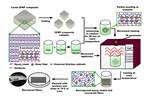DNV, Reodor Studios create digital service for sustainable wind farm decommissioning
New ReWind service will enable recyclability assessment and sustainable end-of-life planning for wind turbines.
Share
Read Next

ReWind digital service platform. Photo Credit: DNV
DNV (Høvik, Norway), in collaboration with Reodor Studios (Oslo, Norway) is creating a digital service called ReWind that will make it easy to report and plan for sustainable decommissioning and recycling when a wind farm has reached the end of its life cycle.
In the 1970s, the wind power industry boomed, and thousands of wind farms were built around the world. Now, 50 years later, the world faces a historic challenge: What do you do with a 300-tonne wind turbine when it has reached the end of its life?
Today, most decommissioned wind turbines are buried underground, for lack of a better solution. In 2020 Bloomberg highlighted the situation in Casper, Wyoming, where 870 wind turbine blades were buried under a landfill. WindEurope estimates that 25,000 tonnes of wind turbine blades will have to be recycled by 2025, and 52,000 tonnes by 2030 (the Re-Wind Network team has also outlined the wind blades landscape, see “Defining the landscape for wind blades at the end of service life”).
DNV’s specialist team analyzes and develops reports for wind farm owners and operators, showing, among other things, which materials the wind turbines contain, how they can be disposed of in the best possible way, what can be recycled and how. Now, in collaboration with Reodor Studios, a Norwegian corporate venture and innovation studio, DNV will shape this into a digital service, combining Reodor’s expertise in building digital products and services with DNV’s domain knowledge, in order to work faster, increase the chances of scaling successfully and build a well-tested service that can make the process of decommissioning wind turbines smoother for wind farm owners and operators.
“This service will enable wind farm owners to quickly assess turbine recyclability percentage and options, end-of-life [EOL] planning and sustainable decommissioning,” Matthew Geraghty, founder and ReWind venture lead at DNV, explains.
DNV’s 2022 Energy Transition Outlook report forecasts that by 2050, wind will provide almost 50% of on-grid electricity in Europe, and 40% in North America and Latin America. New turbine types and bigger turbines, blades and towers will raise capacity factors for onshore wind from 26% now to 34%, and from 38% to 43% for offshore wind by 2050.
“This is the first time in history that we have faced such a challenge. A wind turbine has a life cycle of around 20-30 years, and now many wind turbines are approaching the end of their life cycle,” Lucy Craig, director growth, innovation and digitalization, energy systems at DNV, says. “Today, the process of recycling and decommissioning these is extremely complicated and manual, and large quantities of wind turbines end up in landfills, for lack of better solutions. Introducing this digital service helps the owner plan for decommissioning, map costs, and assess recycling options.”
The digitization project is now ongoing, and the team is now working on validating market needs, developing a service concept, business model and a scalable growth strategy based on customer insights. Learn more about the digital service here.
Related Content
-
Natural fiber composites: Growing to fit sustainability needs
Led by global and industry-wide sustainability goals, commercial interest in flax and hemp fiber-reinforced composites grows into higher-performance, higher-volume applications.
-
Composites end markets: Electronics (2024)
Increasingly, prototype and production-ready smart devices featuring thermoplastic composite cases and other components provide lightweight, optimized sustainable alternatives to metal.
-
Plant tour: Arris Composites, Berkeley, Calif., U.S.
The creator of Additive Molding is leveraging automation and thermoplastics to provide high-volume, high-quality, sustainable composites manufacturing services.















.jpg;maxWidth=300;quality=90)
